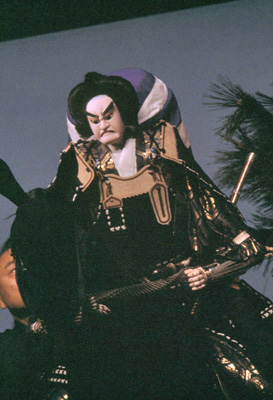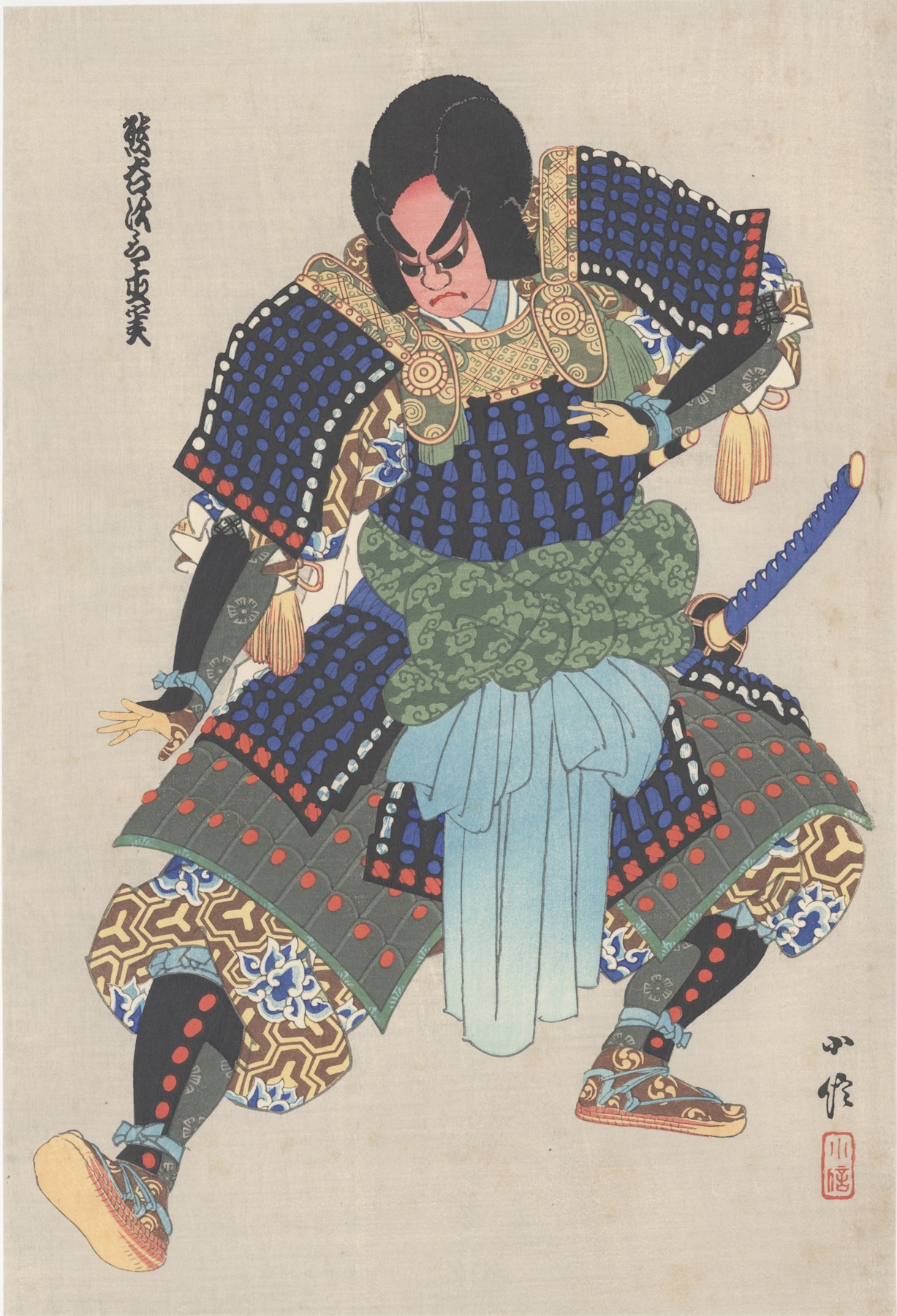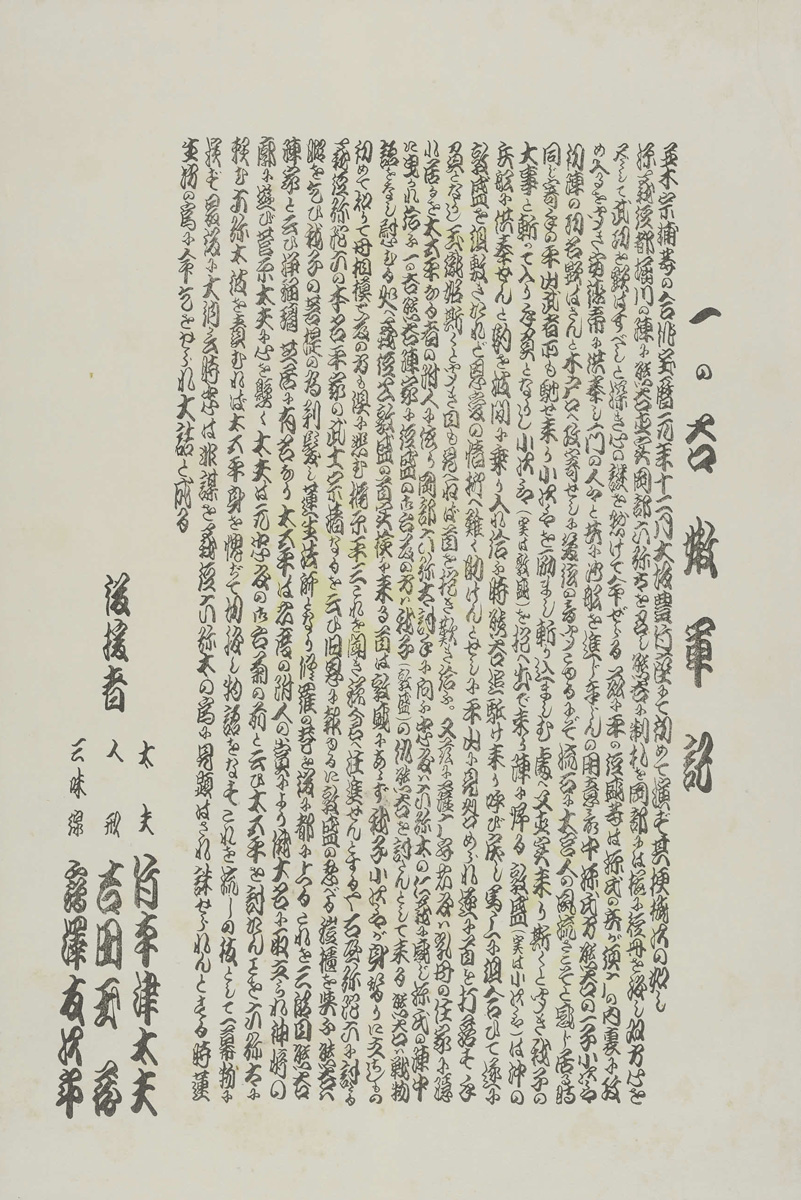About This Print
Picturing the puppet character Kumagai Jirō Naozane in the play Ichi-no-tani Futaba Gunki. Kumagai, a retainer of the Heike General Yoshitsune, will seemingly kill the young Taira warrior Atsumori, but he actually kills his own son who he has substituted for Atsumori. At the end, Kumagai consumed by grief relinquishes his command to spend the rest of his life as a priest praying for the release of his son's spirit.The two acts that are still performed of this five-act play tell the story of the fight between Naozane, and experienced Genji warrior and the Heiki boy warrior Atsumori.

last revision:
For the stage set of this play see Bunraku Theater Stage Set for Ichi-no-tani Futaba Gunki.

Kumagai in The Battle of Ichi-no-tani
image source: Columbia University Libraries: The Barbara Curtis Adachi Bunraku Collection
The Other Prints in the Ichi-no-tani Futaba Gunki Set
As further explained below, each stage set print was part of a set of five prints consisting of a black and white explanatory sheet and three portraits of puppet characters appearing in the play.
explanatory sheet
一の谷嫩軍記 Ichi-no-tani Futaba Gunki
click on image to enlarge
Source: Ritsumeikan University Art Research Center arcBK06-002_14
 The four print set for Ichi-no-tani Futaba Gunki
The four print set for Ichi-no-tani Futaba Gunki
puppets from left to right (as positioned on the stage set print's tissue overlay):

Mukandayū (Mukannotayū) Atsumori 無官太夫敦盛, Kumagi Jirō Naozane 熊谷次郎直実, Tamaori Hime 玉織姫
About the "Illustrated Collection of Famous Japanese Puppets of the Osaka Bunrakuza"
This collection of forty-eight color woodblock prints was designed by Hasegawa Sadanobu III (Konobu III) (1881-1963) and issued over the period March 1926 (Taishō 15) to August 1927 (Shōwa 2)1 by the publishing houses Bijutsusha 美術社 in Tokyo and on a subscription (members only) basis by Hangakai hanmoto 版画会板元 (板畫會板元) in Kyoto. The cost per print set was 3 yen. The editor and publisher for both the Bijutsusha and Hangakai hanmoto sets was Hayashi Eikichi 林榮吉, who was also the editor for Hasegawa's Collection of One Hundred Kumadori Makeups in Kabuki. (See Hasegawa Sadanobu III (Konobu III) (1881-1963) for prints from this collection.)
The Illustrated Collection of Famous Japanese Puppets of the Osaka Bunrakuza consists of twelve sets of prints each set depicting a specific play in the bunraku repertory, as listed in the below table. Each set contains a stage set for the specific play along with three prints of puppet characters appearing in the play and an explanatory sheet, for a total of forty-eight color woodblock prints and twelve monochrome explanatory sheets. Each of the stage set prints was originally issued with a tissue overlay showing the position of the three puppet characters on the stage. All of the plays pictured were performed at the Bunraku Theater (Bunraku-za) located within the Goryō Shrine compound in Osaka. The Goryō Bunraku-za burned down in November 1926 after what has been described as "an extremely difficult managerial era" and "lost interest" by the public in the late Taishō era.2 It is unknown what role, if any, the management of the Goryō Bunraku-za may have played in the formulation and issuance of this print series in their efforts to revitalize the theater.
For more complete information on this series see the article Illustrated Collection of Famous Japanese Puppets of the Osaka Bunrakuza
1 Dates are taken from the colophons on the envelopes containing the print sets in the Waseda University Archives2 National Diet Library website page http://www.ndl.go.jp/scenery/e/column/kansai/goryo_bunrakuza.html which provides a history of the Goryō Bunrakuza.
Play Name in Japanese Play Name in English 壇浦兜軍記
Dan-no-ura kabuto gunki Chronicle of the Battle of Dan-no-ura 義経千本桜
Yoshitsune senbon zakura Yoshitsune and the Thousand Cherry Trees 一の谷嫩軍記
Ichi-no-tani futaba gunki Chronicle of the Battle of Ichinotani 仮名手本忠臣蔵、五段目
Kanadehon Chūshingura, go danme The Treasury of Loyal Retainers, Act 5 仮名手本忠臣蔵、七段目
Kanadehon Chūshingura, shichi danme The Treasury of Loyal Retainers, Act 7 伊賀越道中双六
Igagoe dōchū sugoroku The Revenge at Igagoe 心中天網嶋
Shinjū ten no amajima The Love Suicides at Amijima 新版歌祭文
Shinpan Utazaimon The New Scandalous Ballad of Osome and Hisamatsu 菅原伝授手習鑑
Sugawara Denju Tenarai Kagami Sugawara and the Secrets of Calligraphy 本朝廿四孝
Honchō nijūshikō Twenty-four Examples of Filial Piety 鎌倉三代記
Kamakura sandaiki Three Generations of Kamakura Shoguns 夏祭浪花鑑
Natsumatsuri Naniwa kagami Summer festival at Naniwa (Osaka)
| Play Name in Japanese | Play Name in English |
| 壇浦兜軍記 Dan-no-ura kabuto gunki | Chronicle of the Battle of Dan-no-ura |
| 義経千本桜 Yoshitsune senbon zakura | Yoshitsune and the Thousand Cherry Trees |
| 一の谷嫩軍記 Ichi-no-tani futaba gunki | Chronicle of the Battle of Ichinotani |
| 仮名手本忠臣蔵、五段目 Kanadehon Chūshingura, go danme | The Treasury of Loyal Retainers, Act 5 |
| 仮名手本忠臣蔵、七段目 Kanadehon Chūshingura, shichi danme | The Treasury of Loyal Retainers, Act 7 |
| 伊賀越道中双六 Igagoe dōchū sugoroku | The Revenge at Igagoe |
| 心中天網嶋 Shinjū ten no amajima | The Love Suicides at Amijima |
| 新版歌祭文 Shinpan Utazaimon | The New Scandalous Ballad of Osome and Hisamatsu |
| 菅原伝授手習鑑 Sugawara Denju Tenarai Kagami | Sugawara and the Secrets of Calligraphy |
| 本朝廿四孝 Honchō nijūshikō | Twenty-four Examples of Filial Piety |
| 鎌倉三代記 Kamakura sandaiki | Three Generations of Kamakura Shoguns |
| 夏祭浪花鑑 Natsumatsuri Naniwa kagami | Summer festival at Naniwa (Osaka) |
Print Details
| IHL Catalog | #2488 |
| Title or Description | Kumagi Jirō Naozane in Ichi-no-tani Futaba Gunki [Chronicle of the Battle of Ichi-no-tani] Bunraku ningyō Kumagi Jirō Naozane, Ichi-no-tani 文楽人形 一の谷嫩軍記 腰元濡衣 |
| Series | Illustrated Collection of the Famous Japanese Puppets of the Osaka Bunrakuza Ōsaka Bunraku-za Ningyō Gashū: Nihon Meibutsu 日本名物大阪文楽座人形画集 |
| Artist | Hasegawa Sadanobu III (Konobu III) (1881-1963) |
| Signature |  |
| Seal | 小信 Konobu (see above) |
| Publication Date | Taishō 15 (May 1926) |
| Publisher | 美術社 Bijutsusha, Tokyo and 版画会板元 Hangakai hanmoto, Kyoto |
| Carver | 佐藤重一 Satō Jūichi |
| Printer | 板垣八重松 Itagaki Yaematsu |
| Impression | excellent |
| Colors | excellent |
| Condition | excellent - slightly trimmed; foxing noticeable in background |
| Genre | 文楽人形 bunraku ningyō |
| Miscellaneous | |
| Format | |
| H x W Paper | 14 3/8 x 9 11/16 in. (36.5 x 24.6 cm) |
| H x W Image | 14 3/8 x 9 11/16 in. (36.5 x 24.6 cm) |
| Literature | |
| Collections This Print | Waseda University Cultural Resource Database 201-2489; Ritsumeikan University Art Research Center AcNo. arcBK06-002_17; National Diet Library Call Number 414.38; The Met Thomas J. Watson Library 240.3081 H27 Quarto; British Library System number: 018894603 |
5/15/2021 created



